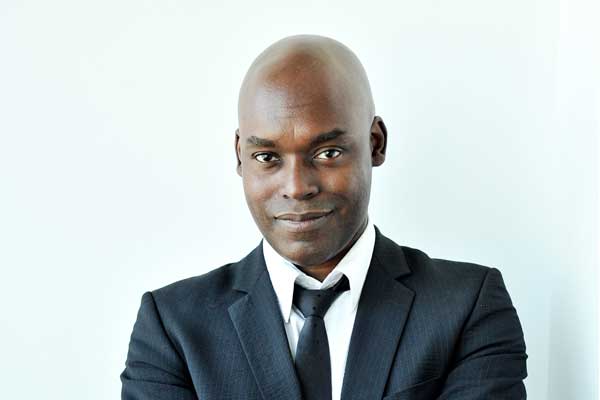
TIFF 2015: talking cinema with U of T's Cameron Bailey, artistic director of the Toronto International Film Festival
Published: September 15, 2015
TIFF artistic director Cameron Bailey tweeted “Well, we’re a day over 40” – as fans lined up to catch a glimpse of actors like Matt Damon, Naomi Watts, Donald Glover and George Clooney.
The Toronto International Film Festival kicked off its new season last week with media coverage predictably focusing on red carpet names such as Natalie Portman or Ridley Scott.
But the crowds that take over Toronto’s streets every fall comprise more cinephiles than celebrity-seekers, Bailey says. “There are so many people who are very informed about film in Toronto.”
An advocate for arts and culture who logged decades of experience as a film critic and programmer before taking the helm of TIFF, Bailey is also a sessional instructor at the University of Toronto. Alumna Lauren Clarke took his popular Programming and Curation class in 2014.
“It gave us all an opportunity to share our thoughts on exhibition and film more broadly,” says Clarke. “It really pushed you to defend your curatorial ideas and choices, as you would have to do in practice. The course fuelled my passion for film and made it clear exhibition is an area of the film industry I want to be a part of.”
U of T News writer Veronica Zaretski spoke with Bailey about TIFF, how students can make the most of the culture scene in Toronto, and the realities of working in the film industry today.
What does the relationship between the city and its arts and culture sector look like in Toronto?
The city of Toronto has benefited greatly from the film scholarship and instruction that takes place here. We have many people on staff here that went through U of T’s Cinema Studies program over the years. So we get very smart, informed people who understand cinema in a very broad way.
We also have a symbiotic relationship with the students and scholars who are in the city, because at TIFF, we offer resources, events and programming, like the higher learning program. One of the things that I love to hear is that people will spend their entire day at the TIFF reference library. All of that makes Toronto one of the top film cities in the world. Few cities can compare to the sophistication of the film audience.
We were fortunate to have been around for 40 years as an institution and to have the resources to help the general public, including students, to gain a better understanding of cinema. No matter how knowledgeable you are, there is always something new to learn.
You’re teaching the Programming and Curation course at U of T again next winter term. What are some of your favourite parts about curating and programming and how does that translate to your teaching work?
I spent many years as a film critic before starting this job. When you’re a critic it’s a little bit like studying – you’re analyzing films to try and figure out how they work. Program curation is different – I’ll try to not just analyze films but analyze how they affect the audience. An understanding of the audience is critical for a curator, as is an understanding of audiences both as groups and as collections of individuals.
I also talk about festivals in the class, which is becoming an important area of study. I bring in my own experience at TIFF and talk about how festivals work as marketplaces for films, curatorial experiences and what they bring to audiences.
I’m really grateful for the opportunity to teach at U of T largely because I also get inspired from talking with students and hearing their perspectives.
We talked about sexual identity in the last class in 2014, and how films present a variety of experiences, as well as what you can assume and not assume from audiences. When I was in university these issues of sexual identity were not talked about as much. I was listening to the students in my seminar talking about that. The class is about engaging everyone in a conversation. And this year, The Danish Girl and About Ray are in the festival and the future is coming up – future filmmakers are making more films like that.
You wrote your first screenplay, The Planet of Junior Brown, in 1997. What has changed over the years for budding filmmakers?
There has been a kind of sea-change in terms of technological breakthroughs. You can now go to a store and get very high quality equipment at a lower price than ever before. It’s exciting for anyone who makes film, and the craft of making a film is still as big and exciting as ever.
But even with newer technology, there are still a lot of barriers to financing film. It can take a while to learn the system to successfully make a film. If you’re lucky enough to get it funded and get it made, getting it out in the world is a lot more challenging than before.
It’s true that you can just put a film online, but if you want to get it out to the world, you have to get it to film distributors, and that in itself is an education. Buying films happens in festivals like ours, and I encourage people who want to get involved in film to observe how that complex part of cinema works.
The landscape for film critics is also different today than it was years before digital media. How does that change the game for today’s aspiring film critics?
The death of cinema critics has been announced many times, but what I think is true is that the traditional role of film critics as practiced in newspapers has declined. I used to write weekly for Now, and the number of positions available in a paper like that has declined.
It’s true that there are many opportunities available online. But it takes initiative and it takes money. Kiva Reardon [programming associate at TIFF and U of T alumna] has done that well – she started her own online journal, cléo, and attracted writers who look at film through a feminist lens.
If you have enough knowledge, drive and perhaps patience, you can do it. You have to be confident. It’s not easy, and no one is going to lay opportunities for you on a carpet – you may have to work harder than before.
Are there Toronto-based filmmakers this year that you're particularly excited about?
There are many. Igor Drljaca’s new film, The Waiting Room, is one of the best we have in the line-up. Kazik Radwanski’s new film, How Heavy this Hammer, is another great addition. These are two very interesting Canadian filmmakers, that really represent the next generation of filmmakers.
I was speaking to [film critic, lecturer and U of T alumnus] Adam Nayman, and we compared them to the Toronto New Wave filmmakers who were making new opportunities in Canadian cinema. In both cases these two filmmakers come from an outsider perspective, as immigrants or looking at Canadian society with the perspective of an outsider.
It's also exciting to see Atom Egoyan, who is now a veteran of the festival, making a film in a new direction. Patricia Rozema is also taking a new direction with her film Into the Forest.



